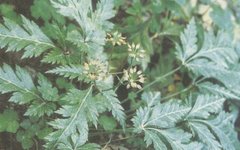
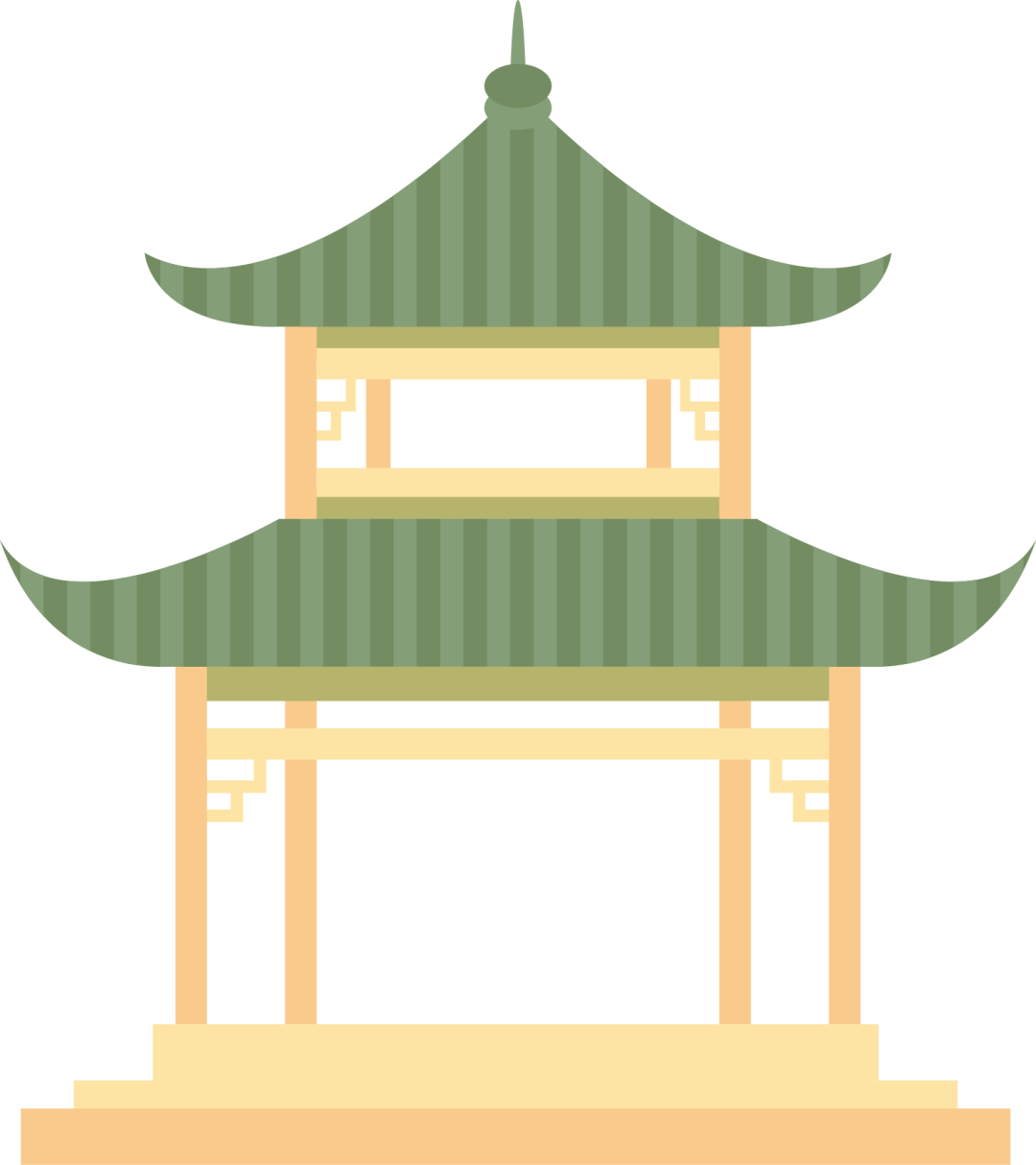
Daily Herb Study
Huang
Lian
Clears
Heat
One
Introduction to Traditional Chinese Medicine (TCM) Herb
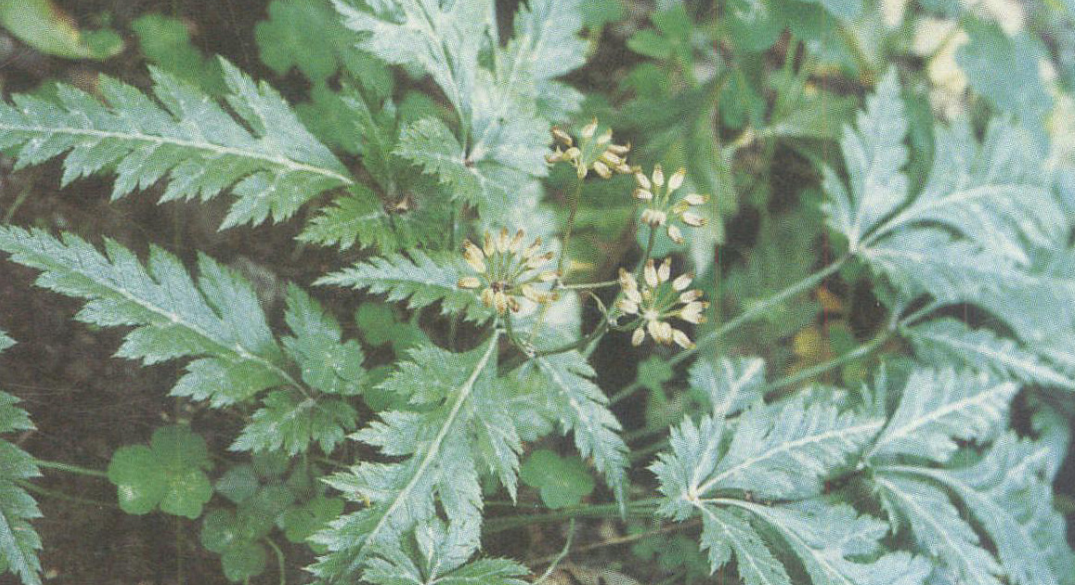
Also known as: Wei Lian, Chuan Lian, Ji Zhua Lian
Properties and Channels: Bitter, Cold. Enters the Heart, Spleen, Stomach, Liver, Gallbladder, and Large Intestine channels.
Functions: Clears heat and dries dampness, drains fire and detoxifies.
Category: Heat-clearing herbs – Heat-clearing and dampness-drying herbs
Herb Description:
Huang Lian, a TCM herb, is the dried rhizome of the plants Coptis chinensis, Coptis teeta, or Coptis deltoidea from the Ranunculaceae family. It has the effects of clearing heat and drying dampness, draining fire, and detoxifying. It is primarily used for treating damp-heat obstruction, vomiting with sour regurgitation, damp-heat diarrhea, high fever with delirium, irritability and insomnia, blood-heat vomiting and nosebleeds, carbuncles and sores, red eyes and toothaches, diabetes, and external treatment of eczema, wet sores, and ear discharge.
Two
TCM Verse
Huang Lian is bitter, drains the heart and relieves fullness,
Clears heat and brightens the eyes, thickens the intestines and stops diarrhea.
Three
Common Combinations
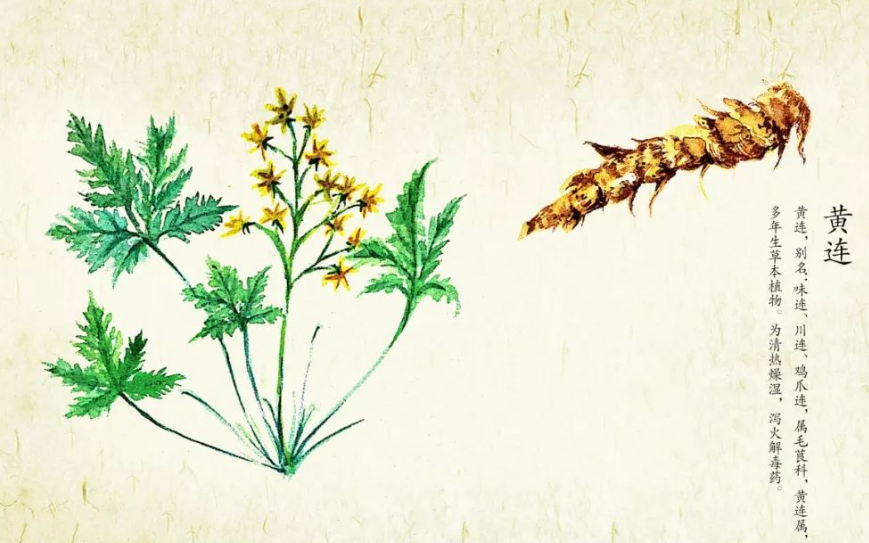
Huang Lian with Mu Xiang Huang Lian is good at clearing heat and drying dampness, which can stop diarrhea; Mu Xiang is good at regulating the middle burner, dispersing qi stagnation, and relieving pain. The combination of these two herbs has the effect of clearing heat and drying dampness, and promoting qi flow. It is suitable for diarrhea and abdominal pain caused by damp-heat stagnation in the gastrointestinal tract.
Huang Lian with Ban Xia Huang Lian is bitter and cold, good at clearing heat and drying dampness, draining fire and detoxifying; Ban Xia is pungent and warm, good at drying dampness, transforming phlegm, and descending rebellious qi. The combination of these two herbs, with their cold and hot properties, can regulate qi dynamics, eliminate damp-heat, transform phlegm turbidity, and has the effects of draining heat and harmonizing the stomach, descending rebellious qi, and clearing phlegm. It is suitable for chest and abdominal distension, fullness in the epigastric region, vomiting, and belching caused by phlegm-heat obstruction and qi stagnation.
Huang Lian with Da Huang Huang Lian can clear heat and dry dampness, drain fire and detoxify; Da Huang can drain fire and promote bowel movements, cool the blood and detoxify. The combination of these two herbs enhances the effects of draining fire, cooling blood, and detoxifying, clearing both the heat in the qi level and the fire toxin in the blood level, while also promoting bowel movements. It is suitable for fullness and oppression in the epigastric region caused by internal heat, abdominal pain and diarrhea due to damp-heat and fire toxin obstruction, red, swollen, and painful eyes, mouth ulcers, swollen and painful gums, or bleeding due to excessive internal heat and abnormal blood circulation.
Huang Lian with Shui Niu Jiao Huang Lian can clear heat and dry dampness, drain fire and detoxify, focusing on clearing heat in the qi level; Shui Niu Jiao can clear heat, detoxify, and cool the blood, focusing on clearing heat in the blood level. The combination of these two herbs enhances the effects of clearing heat, draining fire, and cooling blood. It is suitable for high fever and delirium caused by warm-heat disease entering the nutritive and blood levels, skin rashes, and vomiting blood.
Four
Distribution Areas
1. Huang Lian: Distributed in Hubei, Hunan, Sichuan, Guizhou, Shaanxi, etc.; large-scale cultivation occurs in western Hubei, eastern Sichuan, and southern Shaanxi. 2. Coptis deltoidea: Cultivated in Emei and Hongya areas of Sichuan at high altitudes. Main production areas: primarily produced in Sichuan, Yunnan, and Hubei.
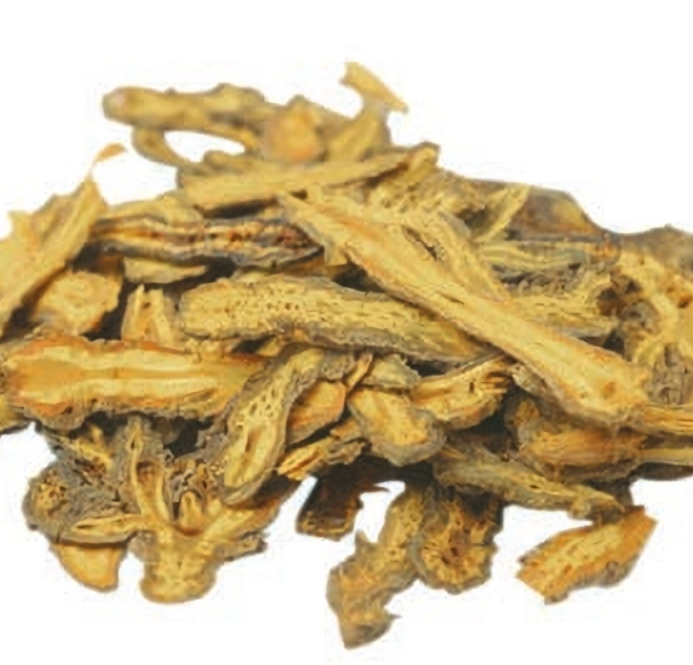
Five
Folklore
It is said that a long time ago, in the Huangshui Dam of Shizhu, there lived a doctor named Tao, who relied on his daughter for companionship. Doctor Tao hired a male assistant named Huang Lian to help him plant flowers and medicinal herbs.
That year, many people near Huangshui contracted a strange illness. Doctor Tao’s daughter was considered lucky as she did not catch this strange illness. One day, while out for a spring outing, she discovered a beautiful wild herb on the hillside. She casually pulled up the wild herb and brought it home to plant in the garden. Huang Lian, who had a crush on her, took care of the flowers and herbs, not forgetting to water the wild herb as well. Over time, the wild herb grew lush and green.
The following summer, Doctor Tao went out to treat patients and did not return home for over ten days. During this time, his daughter fell ill and grew thinner by the day, leaving only skin and bones. Several friends from the village tried every means but could not cure her illness. Huang Lian thought: Why not try the wild herb in the garden? So he pulled up the wild herb, cleaned it, and boiled it whole, roots and leaves included. After a while, he lifted the lid and saw that both the wild herb and the soup had turned yellow. Huang Lian was about to serve it to Doctor Tao’s daughter but hesitated, wondering if it was poisonous. He first tasted the soup and found it very bitter. After two hours, seeing that he was still alive, he knew the wild herb was not poisonous, and only then did he serve a bowl to Doctor Tao’s daughter.
Strangely enough, after drinking the wild herb soup, Doctor Tao’s daughter recovered.
She said to Huang Lian: “This is a good medicine, but it is too bitter.” Huang Lian, who secretly loved her, felt a bit sad as she was completely unaware of his feelings.
When the villagers learned of this news, they all went to dig up the wild herb to make soup, and everyone recovered from their illness.
Not long after, Huang Lian died from his unrequited love at Doctor Tao’s house. Before he died, Doctor Tao’s daughter finally realized his feelings. To commemorate him, people named this bitter herb that clears heat and detoxifies as Huang Lian.
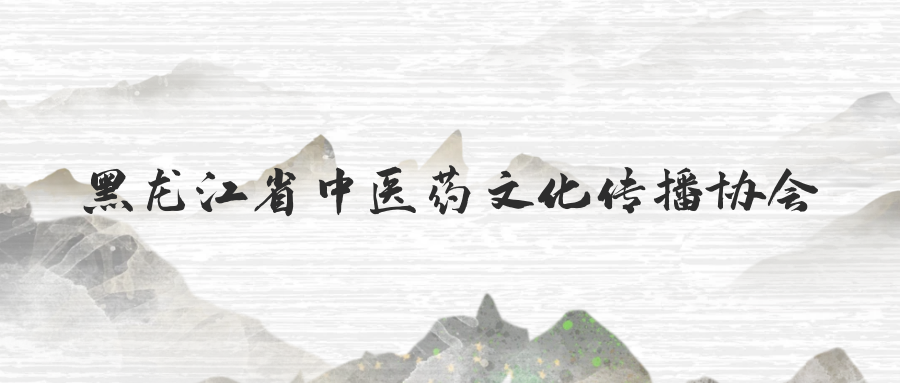
Six
Summary of Ancient Texts
1. “Shen Nong Ben Cao Jing”: “Mainly treats heat, eye pain, tear production, intestinal obstruction, abdominal pain, and swelling and pain in women’s private parts.” 2. “Zhen Zhu Nang”: “Its uses are six: draining heart fire, one; removing damp-heat from the middle burner, two; necessary for all sores, three; removing wind-dampness, four; treating red eyes and eruptions, five; stopping bleeding from the middle, six.” 3. “Ben Cao Zheng Yi”: “Huang Lian is very bitter and very cold, it dries dampness and clears heat, can drain and descend all excess damp-heat, and treats heat in the heart, spleen, liver, kidney, gallbladder, stomach, and large intestine. It clears eye diseases caused by wind-heat above, regulates vomiting caused by liver and stomach heat in the middle, and relieves abdominal pain caused by stagnation below, all of which are effects of drying dampness and clearing heat. Moreover, its bitterness first enters the heart, clearing blood heat, thus treating blood-related diseases such as vomiting blood, hematuria, dysentery, and other symptoms, as well as carbuncles, rashes, and toxic heat. The “Shen Nong Ben Cao Jing” states it is bitter and cold, mainly treating heat, eye pain, tear production, and abdominal pain. Long-term use makes one forgetful. “Ben Cao Jing Ji Zhu” by Tao Hongjing states it is bitter, cold, slightly cold, and non-toxic. It treats heat, eye pain, tear production, abdominal pain, and dysentery. Long-term use stops thirst, calms great fright, removes water, benefits bones, regulates the stomach, thickens the intestines, benefits the gallbladder, and treats mouth sores. Long-term use makes one forgetful. “Lei Gong Pao Zhi Yao Xing Jie” by Li Zhongzi states it is bitter, cold, and non-toxic, entering the heart channel. It treats heart fire, eye diseases, red and swollen sores, dysentery, abdominal fullness, diarrhea in children, mouth sores, anxiety, and heat diseases. Huang Lian is bitter and drains the heart, treating heart fire diseases. Although dysentery belongs to the spleen channel, it is due to fire not being able to generate earth, and the heart and small intestine are interrelated, thus draining heart fire also benefits the small intestine, and the intestines become clear. “Ben Cao Jing Jie” by Ye Tianshi states it is cold, bitter, and non-toxic. It treats heat, eye pain, tear production, abdominal pain, and dysentery. Long-term use makes one forgetful. (Fried with wine, fried with Wu Yao, fried with ginger juice) Huang Lian is cold, inheriting the cold water energy of winter, entering the kidney channel; it is bitter and non-toxic, gaining the fire energy of the southern earth, entering the heart channel. Both properties descend, thus it is yin. It mainly treats heat and eye pain, as the heart governs fire, and heat causes heart disease, which affects the liver, opening the eyes. Huang Lian is bitter and cold, thus it clears fire. The hand Shaoyin channel is located on the face, connecting to the eyes; the hand Shaoyin is the heart fire, and when fire is excessive, it causes tears and eye pain. Huang Lian clears the heart, thus it governs this. In reality, it drains its offspring, as the heart is the offspring of the liver wood. Clearing the heart also drains liver evil, thus brightening the eyes. The large intestine is the metal organ, and when heart fire dominates, body fluids turn into pus and blood, causing pain and diarrhea; it governs this with cold to clear fire and bitterness to drain heat. The northern black color enters the kidney, opening the two yin; the female private part is the kidney orifice, and when heat is excessive, it swells and causes pain, which is due to excessive fire. Huang Lian enters the kidney, cold and bitter, clearing fire, thus it governs this. Long-term use makes one forgetful, as it enters the heart to clear fire, and when the fire is clear, the heart is bright, thus enhancing memory. “Changsha Yao Jie” by Huang Yuanyu states it is bitter, cold, entering the hand Shaoyin heart channel. It clears the heart, reduces heat, drains fire, and relieves anxiety. “Ming Yi Bie Lu” states it is slightly cold, non-toxic, treating the five organs’ heat and cold. Long-term use stops diarrhea, hematuria, and other symptoms. It removes water, benefits bones, regulates the stomach, thickens the intestines, benefits the gallbladder, and treats mouth sores. Harvested in February and August. (Huang Qin, Long Gu, and Shi Shi are used with it. Avoid Chrysanthemum, Yan Hua, and Xuan Shen. Be cautious with Kuan Dong Hua. It is superior to Wu Tou. It detoxifies Ba Dou poison.)
/

/
WeChat ID|Longjiang TCM Culture
Click to Follow
Some content of the article is referenced from: Baidu Zhihu
Previous TCM Herb Reviews
Daily Herb Study: Mi Meng Hua
Daily Herb Study: Han Shui Shi
Daily Herb Study: Dan Zhu Ye
Daily Herb Study: Zhi Zi
Daily Herb Study: Qing Sang Zi

